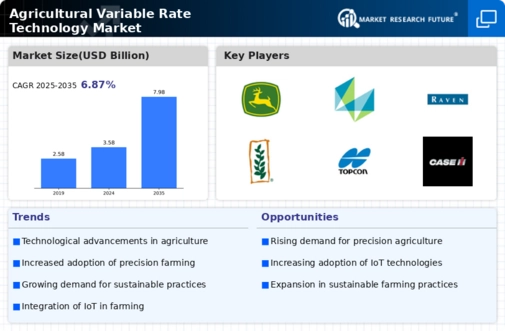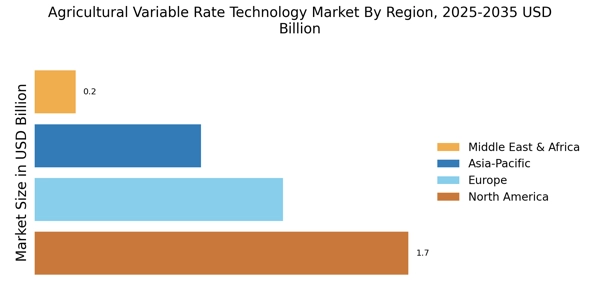Rising Demand for Food Security
The Agricultural Variable Rate Technology Market is experiencing a surge in demand driven by the need for enhanced food security. As the global population continues to grow, the pressure on agricultural systems intensifies. Farmers are increasingly adopting variable rate technology to optimize crop yields and ensure efficient resource utilization. This technology allows for precise application of inputs such as fertilizers and pesticides, which can lead to improved crop health and productivity. According to recent data, the adoption of such technologies has been linked to yield increases of up to 20%. This trend indicates a strong potential for growth within the Agricultural Variable Rate Technology Market as stakeholders seek innovative solutions to meet the escalating food demands.
Government Initiatives and Support
Government initiatives play a pivotal role in shaping the Agricultural Variable Rate Technology Market. Various countries are implementing policies and providing financial incentives to promote the adoption of precision agriculture technologies. These initiatives often include subsidies for technology acquisition, training programs for farmers, and research funding aimed at developing advanced agricultural practices. For instance, certain regions have reported a 15% increase in technology adoption rates due to government-backed programs. Such support not only enhances the accessibility of variable rate technologies but also fosters a conducive environment for innovation and growth within the Agricultural Variable Rate Technology Market.
Increasing Awareness and Education
The Agricultural Variable Rate Technology Market is also benefiting from increasing awareness and education among farmers and agricultural stakeholders. As more information becomes available regarding the advantages of variable rate technology, farmers are more inclined to adopt these practices. Educational programs, workshops, and demonstrations are being organized to showcase the effectiveness of precision agriculture. This growing awareness is crucial, as it helps to dispel misconceptions and highlights the potential return on investment associated with adopting such technologies. As a result, the Agricultural Variable Rate Technology Market is expected to witness a steady increase in adoption rates, driven by informed decision-making and a better understanding of the technology's benefits.
Focus on Sustainable Farming Practices
Sustainability is becoming a central theme within the Agricultural Variable Rate Technology Market. As environmental concerns rise, farmers are seeking methods to reduce their ecological footprint while maintaining productivity. Variable rate technology allows for the targeted application of inputs, minimizing waste and reducing the risk of runoff into water bodies. This approach aligns with sustainable farming practices, which are increasingly prioritized by consumers and regulatory bodies alike. Reports indicate that farms utilizing variable rate technology can reduce fertilizer usage by up to 30%, showcasing the potential for both economic and environmental benefits. This focus on sustainability is likely to drive further investment and innovation within the Agricultural Variable Rate Technology Market.
Technological Advancements in Agriculture
The Agricultural Variable Rate Technology Market is significantly influenced by ongoing technological advancements. Innovations in sensors, data analytics, and machine learning are transforming traditional farming practices. These technologies enable farmers to collect and analyze data in real-time, facilitating informed decision-making regarding resource allocation. For example, the integration of drones and satellite imagery allows for precise mapping of field variability, which is crucial for effective variable rate applications. As these technologies become more sophisticated and affordable, their adoption is expected to rise, further propelling the growth of the Agricultural Variable Rate Technology Market. The market is projected to expand as farmers increasingly recognize the benefits of these advancements.


















Leave a Comment